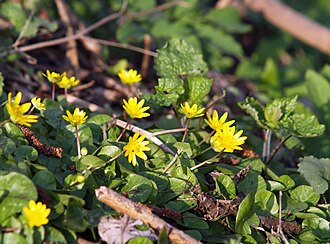Translations:Adventist Youth Honors Answer Book/Outdoor Industries/Agriculture/13/en
From Pathfinder Wiki
Ranunculus ficaria
| Ranunculus ficaria (Lesser celandine) | |
|---|---|
|
Where found: The plant is found throughout Europe and west Asia and is now introduced in North America.
Description: The window of opportunity for controlling lesser celandine is very short, due to its life cycle. In order to have the greatest negative impact to celandine and the least impact to desirable native wildflower species, herbicide should be applied in late winter-early spring (March through May). Apply a 1.5% rate of a 39 to 41% glyphosate isopropylamine salt (e.g., Rodeo® for wetland areas) mixed with water and a non-ionic surfactant to foliage, avoiding application to anything but the celandine. Glyphosate is systemic; that is, the active ingredient is absorbed by the plant and translocated to the roots, eventually killing the entire plant. The full effect on the plant may take 1-2 weeks. Applications can be made during the winter season as long as the temperature is above about 50 degrees Fahrenheit, and no rain is anticipated within 12 hours. Because glyphosate is non-specific, spray should be controlled such that it touches only lesser celandine and does not drift onto desirable plants. To minimize impacts to sensitive-skinned frogs and salamanders, some experts recommend applying herbicide in March and then switching to manual methods.
|
 |
